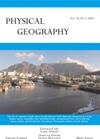Assessing poison ivy (Toxicodendron radicans) presence and functional traits in relation to land cover and biophysical factors
IF 1.4
4区 地球科学
Q4 ENVIRONMENTAL SCIENCES
引用次数: 1
Abstract
ABSTRACT Understanding species distributions remains central to research in ecology and biogeography. Emphasis is placed on the spatial presence/absence of plants as related to underlying environmental factors; however, distributions result from both abiotic factors and adaptations to the abiotic environment. We analyzed poison ivy (Toxicodendron radicans (L.) Kuntze), which has high intraspecies variability in the plant functional trait of growth habit, to assess implications of plant strategies for spatial distributions. Our objectives were to: 1) determine whether anthropogenic habitats are statistically overrepresented in poison ivy incidence and growth habits (shrub, climbing liana, crawling liana), and 2) model biophysical parameters that constitute preferred poison ivy habitat and the three growth habits. We collected poison ivy field data along a trail-transect with corresponding geospatially indexed parameters, subsequently analyzed using Bayesian spatial modeling. Model results revealed poison ivy preference for human-modified habitat; Developed and Planted/Cultivated land use categories showed the largest marginal posterior probabilities for crawling and climbing lianas. Increasing temperature and elevation preferentially benefit the climbing growth habit. Our results suggest that variability in functional traits may impact species geographic distributions by expanding niche breadth. Incorporation of functional traits may thus advance predictive niche models of species distributions.评估毒藤的存在及其与土地覆盖和生物物理因素相关的功能特征
了解物种分布仍然是生态学和生物地理学研究的核心。重点放在与潜在环境因素相关的植物的空间存在/缺失上;然而,这种分布是由非生物因素和对非生物环境的适应共同造成的。我们分析了毒葛(Toxicodendron radicans, L.)Kuntze)在植物生长习性的功能性状上具有较高的种内变异性,以评估植物策略对空间分布的影响。我们的目标是:1)确定人类栖息地在毒藤发病率和生长习性(灌木、攀缘藤本植物、爬行藤本植物)中是否有统计学上的过度代表;2)建立构建首选毒藤栖息地和三种生长习性的生物物理参数模型。我们收集了带有相应地理空间索引参数的小道样带毒藤田数据,随后使用贝叶斯空间建模进行分析。模型结果显示,毒葛对人类改造生境的偏好;已开发和种植/耕地利用类型对藤本植物的边际后验概率最大。温度和海拔的升高有利于攀援生长。我们的结果表明,功能性状的变异可能通过扩大生态位宽度来影响物种的地理分布。因此,结合功能性状可以推进物种分布的预测生态位模型。
本文章由计算机程序翻译,如有差异,请以英文原文为准。
求助全文
约1分钟内获得全文
求助全文
来源期刊

Physical Geography
地学-地球科学综合
CiteScore
3.60
自引率
0.00%
发文量
18
审稿时长
6 months
期刊介绍:
Physical Geography disseminates significant research in the environmental sciences, including research that integrates environmental processes and human activities. It publishes original papers devoted to research in climatology, geomorphology, hydrology, biogeography, soil science, human-environment interactions, and research methods in physical geography, and welcomes original contributions on topics at the intersection of two or more of these categories.
 求助内容:
求助内容: 应助结果提醒方式:
应助结果提醒方式:


